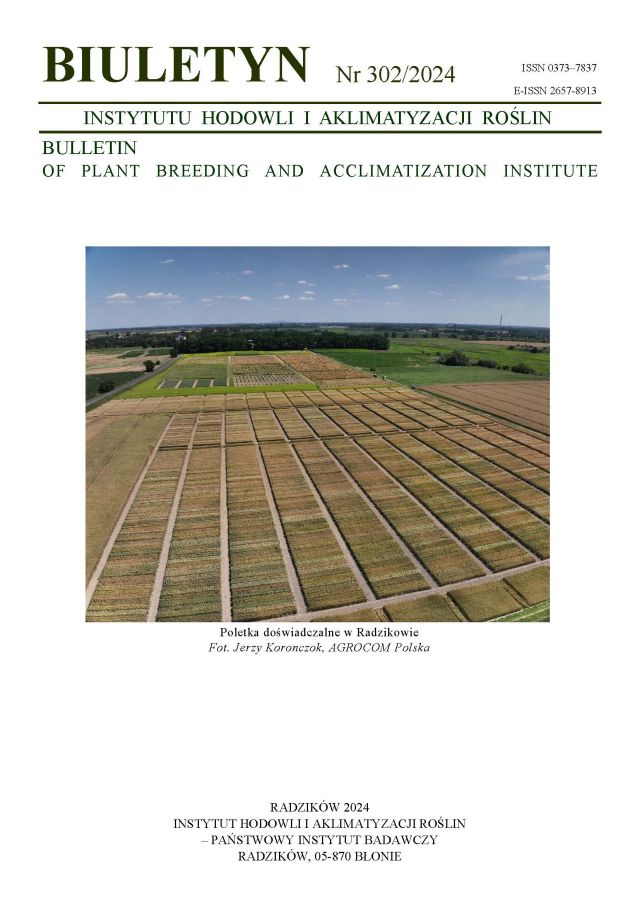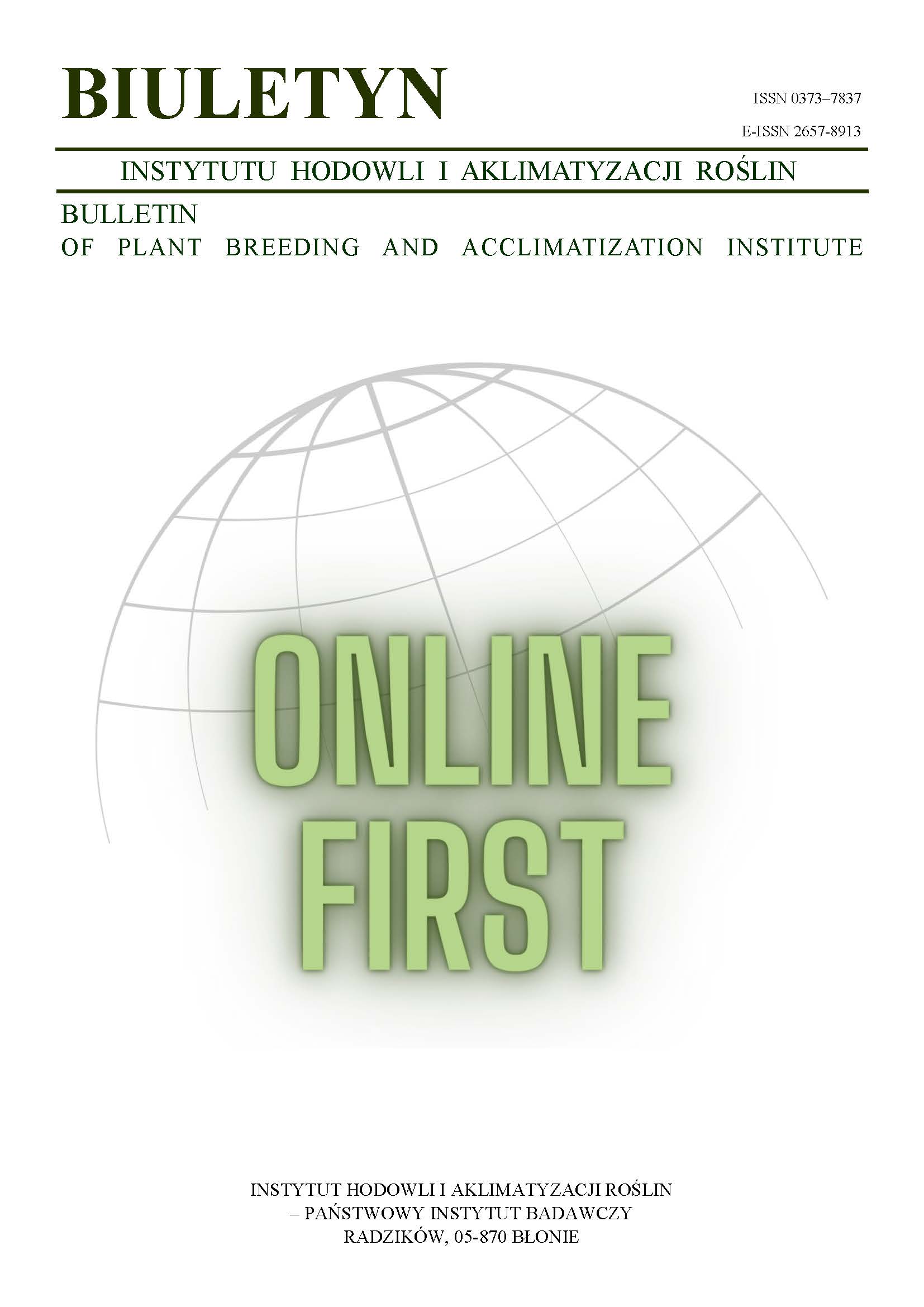The response of oat to different methods of PKMg application at conventional and no-tillage systems
Jolanta Korzeniowska
iung@iung.pulawy.plInstytut Uprawy Nawożenia i Gleboznawstwa — Państwowy Instytut Badawczy w Puławach, Zakład Technik Uprawy Roli i Nawożenia w Jelczu-Laskowicach (Poland)
Ewa Stanisławska-Glubiak
Instytut Uprawy Nawożenia i Gleboznawstwa — Państwowy Instytut Badawczy w Puławach, Zakład Technik Uprawy Roli i Nawożenia w Jelczu-Laskowicach (Poland)
Abstract
Oat yielding and contents of macronutrients in oat plants at broadcast and deep-band fertilization, and at conventional and no-tillage systems were compared in 3-year field trials. In the deep-band method the fertilizer was applied 5 cm below the seeds with the use of no-tilling disk drill made by the “Great Plains” company. Phosphorus (P), potassium (K) and magnesium (Mg) were supplied in the form of a multicomponent fertilizer — Polimag 305. The broadcast method effected better yielding than the deep-band one at both tillage systems. Unexpectedly, this effect was more pronounced at the no-tillage variant. Lack of rain in the periods critical for oat growth and development made no-tillage system more effective. In the whole period of the investigations, the plants at the shooting stage were found to be better supplied with P, K and Mg in the no-tillage trials than in the trials where the conventional tillage system was applied. The broadcast fertilization, compared with the deep-band one, generally resulted in higher concentrations of P and K in the above-ground part of oat plants, whether the conventional or no-tillage system was used. However, the positive effects of the broadcast method were more pronounced at the conventional tillage.
Keywords:
broadcast fertilization, conventional tillage, macronutrients, deep-band fertilization, grain yield, no tillage, oatReferences
Franzluebbers A. J., Hons F. M. 1996. Soil-profile distribution of primary and secondary plant-available nutrients under conventional and no tillage. Soil and Tillage Research 39: 229 — 239.
DOI: https://doi.org/10.1016/S0167-1987(96)01056-2
Google Scholar
Galvez L., Douds Jr. D. D., Drinwater L. E., Wagoner P. 2001. Effect of tillage and farming system upon VAM fungus populations and mycorrhizas and nutrient uptake of maize. Plant and Soil 228 (2): 299 — 308 (10).
DOI: https://doi.org/10.1023/A:1004810116854
Google Scholar
Gordon W. B. 1999. Starter fertilizers containing potassium for ridge-till corn and soybean production. Better Crops 83, (2): 22 — 23.
Google Scholar
Gordon W. B., Whitney D. A., Fjell D. L. 1998. Starter fertilizer interactions with corn and grain sorghum hybrids. Better Crops 82 (2): 16 — 19.
Google Scholar
Hoeft R. G., Ritchie K. B. 1997. Starter fertilizer boosts yields of no-till corn. Better Crops 81 (1): 12 — 13.
Google Scholar
Kordas L. 1999. Wpływ stosowania siewu bezpośredniego na nakłady energetyczne i plonowanie pszenicy ozimej. Zesz. Nauk. AR Wrocław, Rol., 367: 135 — 139.
Google Scholar
Kuś J. 1999. Wpływ różnej intensywności uprawy roli na jej właściwości i plonowanie roślin. Fol. Univ. Agric. Stetin 195 Agricultura (74): 33 — 38.
Google Scholar
Mallarino A. P., Barker D. W., Borges R., North J. C. 1998. Tillage and fertilizer placement for the corn-soybean rotation. Proceedings of the Integrated Crop Management Conference, November 17-18 1998, Iowa State Univ. Extension Ames, USA: 231 — 237.
DOI: https://doi.org/10.31274/icm-180809-621
Google Scholar
Mascagni H. J., Bouquet D. J. 1998. Influence of starter fertilizer on corn rotated with cotton. Better Crops 82 (2): 3 — 5.
Google Scholar
Metody badań laboratoryjnych w stacjach chemiczno-rolniczych. 1980. IUNG Puławy: I — IV.
Google Scholar
Miller T. D. 1998. Deep phosphorus banding in winter wheat — a risk management tool for the Southern Great Plains. Better Crops 82 (4): 26 – 28.
Google Scholar
Nelson W. L. 1981. A „Blueprint” for maximizing yields of soybeans. In: Agricultural yield potentials in continental climates. 16th Colloquium of the Intern. Potash Inst. Bern — Warszawa: 257 — 265.
Google Scholar
Pabin J., Włodek S., Biskupski A. 2001. Retencja wodna gleby w uprawie zerowej. VIII Międzynarodowe Sympozjum „Ekologiczne aspekty mechanizacji produkcji roślinnej”, Warszawa 6–8 września: 181 — 186.
Google Scholar
Pabin J., Włodek S., Biskupski A., Runowska-Hryńczuk B., Kaus A. 1999. Wpływ energooszczędnych technik uprawy roli na właściwości gleby i plony roślin. VI Międzynarodowe Sympozjum “Ekologiczne aspekty mechanizacji nawożenia, ochrony roślin i uprawy gleby”, Warszawa: 169 — 176.
Google Scholar
Potassium application methods. 1998. Potash & Phosphate Institute Better Crops, 82 (3): 24 – 26.
Google Scholar
Szczegółowa uprawa roślin. 2003. Praca zbiorowa pod red. Zofii Jasińskiej i Andrzeja Koteckiego. Tom I, Wyd. AR Wrocław: 502 ss.
Google Scholar
Randall G. W., Hoeft P. R. 1997. Fertilizer placement methods. New wrinkles on a new face. Soil Science/Horticulture/Agronomy 326: http://www.soil.wisc.edu/barak/soilscience326.
Google Scholar
Weber R. 2004. Zmienność plonowania odmian pszenicy ozimej w zależności od przedplonu i sposobu uprawy roli. Wyd. IUNG, Puławy, Monografie i Rozprawy Naukowe, 12: 88 ss.
Google Scholar
Westermann D. T., Tindall T. A. 1998. Potassium fertilization of Russet Burbank potatoes. Better Crops 82 (2): 8 — 12.
Google Scholar
Wulfsohn D., Gu Y., Wulfsohn A., Mojlaj E. G. 1996. Statistical analysis of wheat root growth patterns under conventional and no-till systems. Soil and Tillage Research 38 (1–2): 1 — 16.
DOI: https://doi.org/10.1016/0167-1987(96)01019-7
Google Scholar
Vyn T., Janovicek K., Bruulsema T. 1999. Banded potash boosts no-till corn yield. Better Crops 83 (3): 8 — 9.
Google Scholar
Yin X., Vyn T. J. 2002. Residual effects of potassium placement for conservation-till corn on subsequent no-till soybean. Soil and Tillage Research 75: 151 — 159.
DOI: https://doi.org/10.1016/S0167-1987(03)00155-7
Google Scholar
Zalecenia nawozowe dla gospodarstw korzystających z oznaczeń odczynu i zasobności gleb Stacji Chemiczno-Rolniczych. 1996. Wyd. IUNG, Puławy: 28 ss.
Google Scholar
Authors
Jolanta Korzeniowskaiung@iung.pulawy.pl
Instytut Uprawy Nawożenia i Gleboznawstwa — Państwowy Instytut Badawczy w Puławach, Zakład Technik Uprawy Roli i Nawożenia w Jelczu-Laskowicach Poland
Authors
Ewa Stanisławska-GlubiakInstytut Uprawy Nawożenia i Gleboznawstwa — Państwowy Instytut Badawczy w Puławach, Zakład Technik Uprawy Roli i Nawożenia w Jelczu-Laskowicach Poland
Statistics
Abstract views: 21PDF downloads: 8
License
Copyright (c) 2006 Jolanta Korzeniowska, Ewa Stanisławska-Glubiak

This work is licensed under a Creative Commons Attribution-ShareAlike 4.0 International License.
Upon submitting the article, the Authors grant the Publisher a non-exclusive and free license to use the article for an indefinite period of time throughout the world in the following fields of use:
- Production and reproduction of copies of the article using a specific technique, including printing and digital technology.
- Placing on the market, lending or renting the original or copies of the article.
- Public performance, exhibition, display, reproduction, broadcasting and re-broadcasting, as well as making the article publicly available in such a way that everyone can access it at a place and time of their choice.
- Including the article in a collective work.
- Uploading an article in electronic form to electronic platforms or otherwise introducing an article in electronic form to the Internet or other network.
- Dissemination of the article in electronic form on the Internet or other network, in collective work as well as independently.
- Making the article available in an electronic version in such a way that everyone can access it at a place and time of their choice, in particular via the Internet.
Authors by sending a request for publication:
- They consent to the publication of the article in the journal,
- They agree to give the publication a DOI (Digital Object Identifier),
- They undertake to comply with the publishing house's code of ethics in accordance with the guidelines of the Committee on Publication Ethics (COPE), (http://ihar.edu.pl/biblioteka_i_wydawnictwa.php),
- They consent to the articles being made available in electronic form under the CC BY-SA 4.0 license, in open access,
- They agree to send article metadata to commercial and non-commercial journal indexing databases.














